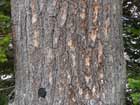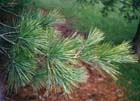Conservation Status

Pinus strobus
Linnaeus 1753, p. 1001
Common names
Eastern white pine, northern white pine, white pine; pin blanc [French]; biisaandago-zhingwaak [Ojibwe]; ストロ-ブマツ [Japanese].
Taxonomic notes
Syn: Strobus strobus (Linnaeus) Small (Kral 1993). Formerly, many authors regarded Pinus chiapensis as a variety of P. strobus, but it is now generally seen as a distinct species.
Description
Trees to 30-67 m tall and 100-180 cm in diameter, straight; crown conic, becoming rounded to irregular or flattened. Bark darkening and thickening as tree ages, becoming gray-brown, deeply furrowed with broad ridges of irregularly rectangular, purple-tinged scaly plates. Branches whorled, spreading-upswept; twigs slender, pale red-brown, glabrous or pale puberulent, aging gray, ±smooth. Buds ovoid-cylindric, light red-brown, 0.4-0.5 cm, slightly resinous. Needles 5 per fascicle, spreading to ascending, persisting 2-3 years, 6-10 cm × 0.7-1 mm, straight, slightly twisted, pliant, deep green to blue-green, pale stomatal lines evident only on adaxial surfaces, margins finely serrulate, apex abruptly acute to short-acuminate; sheath 1-1.5 cm, shed early. Staminate cones numerous, ellipsoid, 10-15 mm, yellow. Ovulate cones maturing in 2 years, shedding seeds and falling soon thereafter, clustered, pendent, symmetric, cylindric to lance-cylindric or ellipsoid-cylindric before opening, ellipsoid-cylindric to cylindric or lance-cylindric when open, (7)8-20 cm, gray-brown to pale brown, with purple or gray tints, stalks 2-3 cm; apophyses slightly raised, resinous at tip; umbo terminal, low. Seeds compressed, broadly obliquely obovoid; body 5-6 mm, tapering at both ends, red-brown mottled with black; wing 1.8-2.5 cm, pale brown. 2n=24 (Elias 1987, Kral 1993). See García Esteban et al. (2004) for a detailed characterization of the wood anatomy.
Distribution and Ecology
Canada: Newfoundland, Nova Scotia, New Brunswick, Prince Edward Island, Québec, Ontario, and Manitoba; France: St. Pierre and Miquelon; and USA: Connecticut, Delaware, District of Columbia, Georgia, Iowa, Illinois, Indiana, Kentucky, Maine, Maryland, Massachusetts, Michigan, Minnesota, New Hampshire, New Jersey, New York, North Carolina, Ohio, Pennsylvania, Rhode Island, South Carolina, South Dakota, Tennessee, Vermont, Virginia, West Virginia, Wisconsin. Found at sea level in the north, and up to 1500 m in the south. Does best on well-drained soils with a cool, humid climate. Forms mixed stands with Tsuga canadensis, Quercus sp., or Fraxinus americana. (Elias 1987, Kral 1993). See also Thompson et al. (1999). Hardy to Zone 3 (cold hardiness limit between -39.9°C and -34.4°C) (Bannister and Neuner 2001).
Distribution data from USGS (1999). Points represent isolated or approximate locations.
Remarkable Specimens
The official largest tree by the "point" system is 185 cm dbh, height 40.2 m, in Morrill, Maine (American Forests 2007). The largest known by stem volume is a tree found in July 2023 in the Moose River Plains Wild Forest, New York. It measures 159 cm (62.6 in) dbh and has an estimated wood volume of 41 m3 (1450 ft3) (Bennett 2023). Larger specimens were recorded historically; the Rich Mountain pine in Tennessee was 186 cm dbh (230 inches in girth) and 51.2 m (168 feet) tall with a broken top when it was logged (Blozan [no date]). The tallest known living tree is the "Boogerman Pine" in Great Smoky Mountains National Park; it was reported as 56.54 m tall (Rucker 2003) and Blozan in a 2019 Facebook post reported a 57.57 m height via tape drop in 2017, and stated it was still living in early 2019 but somewhat shorter due to top damage. A tree in the Chattooga River watershed in Georgia is nearly as tall at 56.32 m (Riddle 2016).
The oldest known log was found at Swan Lake, Algonquin Provincial Park, Ontaria by R.P. Guyette and B. Cole. This log, specimen SWW51, had 407 crossdated rings (NCDC 2006). This was a subfossil log from the lake; its limiting dates are 1432-1838 (Guyette and Cole 1999). If you want a live tree, tree 042072 might still be living at Wilmington Notch, New York. When collected in 1982 by Ed Cook, this sample had 350 rings (NCDC 2006).
Ethnobotany
P. strobus was a valued source of naval stores in the 1700s, and large tracts were once reserved for exploitation by the Royal Navy (Kral 1993). This exploitation began in 1652, and by 1775 the easy sources of wood for masts had been largely logged off (Ponting 1991). (Note: also in 1652, John Hull of Boston established the New England Mint; his largest issue was a coin ornamented by a pine tree, surely P. strobus (Connor 1994).) The logging continued through the 1700s and 1800s for masts, buildings, and furniture (Elias 1987). Because of extensive lumbering, few uncut stands remain (Kral 1993). As time went by, the locus of devastation migrated westward, and has left a legacy in the form of historic buildings framed with pine from Maine to Minnesota. An enjoyable review of the species' importance in historical Minnesota can be found HERE.
In modern times, it is an important horticultural species (Elias 1987). Twice (as of 2024) trees from Maryland have served as the U.S. Capitol Christmas tree, the only pine ever selected for that duty.
Observations
Some fine old-growth stands are said to remain in Algonquin Provincial Park, Ontario, despite extensive historical logging (Thompson et al. 2006). The stand at Cathedral Grove, Minnesota (Anderson et al. 2002) sounds interesting; researchers there built deer exclosures and found that deer and snowshoe hare browsing had been virtually eliminating seedling recruitment in the stand.
Remarks
The epithet strobus is from the Greek for "pine cone".
Mast years at 3 to 5 year intervals provide a seed crop important to wildlife (Elias 1987). White pine blister rust (Cronartium ribicola), an introduced fungal disease, has decimated formerly extensive stands of this and certain other white pines (Little 1980).
Eastern white pine is the provincial tree of Ontario and the state tree of Maine and Michigan (Kral 1993).
A decline syndrome has recently been identified in which trees exhibit deformed foliage and produce stress crops of cones shortly before dying. It may be caused or exacerbated by air pollution (Hawkes 2001).
Citations
American Forest. 2007. National Register of Big Trees. http://www.americanforests.org/resources/bigtrees/register.php, accessed 2007.03.30, now defunct.
Anderson, C.E., K.A. Chapman, M.A. White, and M.W. Cornett. 2002. Effects of browsing control on establishment and recruitment of eastern white pine (Pinus strobus L.) at Cathedral Grove, Lake Superior highlands, Minnesota, USA. Natural Areas Journal 22(3): 202-210.
Bennett, Chloe. 2023.07.16. Huge Eastern white pine discovered in the Adirondacks. https://www.adirondackexplorer.org/stories/huge-eastern-white-pine-in-remote-adirondack-forest-measures-as-largest, accessed 2023.08.06.
Blozan, Will. [no date]. Historical photos. http://www.nativetreesociety.org/galleries/historical/historical_photos.htm, accessed 2007.08.27, now defunct.
Connor, Sheila. 1994. New England Natives, A Celebration of People and Trees. Cambridge, MA: Harvard University Press, 274 pp. ISBN 0-674-61350-3.
Guyette, R.P. and W.G. Cole. 1999. Age characteristics of coarse woody debris (Pinus strobus) in a lake littoral zone. Canadian Journal of Fisheries and Aquatic Sciences 56: 496-505.
Hawkes, Gerry. 2001. Air pollution & forest death. http://www.biketrack.com/pollution.htm accessed 2001.02.21, now defunct.
[NCDC 2006] Data accessed at the National Climatic Data Center World Data Center for Paleoclimatology Tree-Ring Data Search page. http://hurricane.ncdc.noaa.gov/pls/paleo/fm_createpages.treering, accessed 2006.09.08, now defunct.
Ponting, C. 1991. A Green History of the World. New York: St. Martin's Press, 432 pp. ISBN 0-312-06989-1.
Riddle, Jess. 2016. Re: Warwoman Road Update. http://www.ents-bbs.org/viewtopic.php?f=73&t=1879, accessed 2017.11.04.
Thompson, I.D., J.H. Simard, and R.D. Titman. 2006. Historical changes in white pine (Pinus strobus L.) density in Algonquin Park, Ontario, during the 19th century. Natural Areas Journal 26(1): 61-71.
See also
Elwes and Henry 1906-1913 at the Biodiversity Heritage Library. This series of volumes, privately printed, provides some of the most engaging descriptions of conifers ever published. Although they only treat species cultivated in the U.K. and Ireland, and the taxonomy is a bit dated, still these accounts are thorough, treating such topics as species description, range, varieties, exceptionally old or tall specimens, remarkable trees, and cultivation. Despite being over a century old, they are generally accurate, and are illustrated with some remarkable photographs and lithographs.
FEIS database.
Prasad and Iverson 1999.








